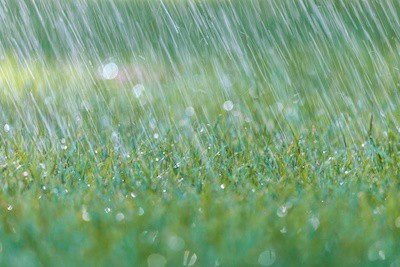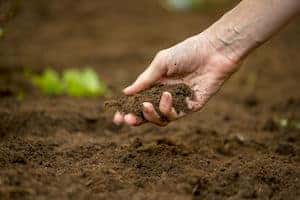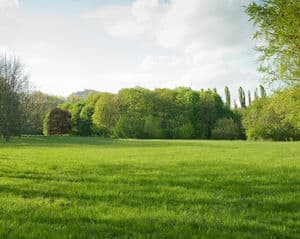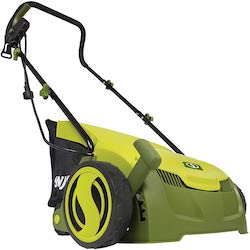If your lawn has ever encountered lawn bubbles or grass bubbles, you may have imagined that they were mini volcanoes about to erupt with an explosion of sod all the while watching your kids enjoying jumping on them like they were playing on trampolines. While there is generally no impending danger from lawn bubbles, they are definitely not the look most people desire for their lawns. Additionally, lawn bubbles can be harmful to the growth of your lawn. Keep reading for some helpful tips to help you get rid of them.
Why does my lawn have bubbles? This is caused when ground becomes overly saturated and your lawn is unable to absorb excess amounts of water. When the water accumulates, it becomes trapped below the surface of the grass root and rhizome layer. This causes the grass to “float” on top of the water creating a “grass bubble” (also known as a lawn bubble, lawn blister, or waterbed).
It is important to address problems like lawn bubbles before your yard receives unnecessary amounts of damage. In this post, we will share more about what causes lawn blisters as well as a few helpful tips to eradicate them indefinitely.
The Origin of Lawn Bubbles And How To Eradicate Them
 Lawn blisters are usually soft and soggy with a texture similar to a waterbed that creates a sloshing sound when pressed. Most often you will find these blisters between the tightly-woven sod and the plastic sheeting under the turf. However, grass bubbles can form beneath tightly growing grass and sod where there is no plastic beneath the grass.
Lawn blisters are usually soft and soggy with a texture similar to a waterbed that creates a sloshing sound when pressed. Most often you will find these blisters between the tightly-woven sod and the plastic sheeting under the turf. However, grass bubbles can form beneath tightly growing grass and sod where there is no plastic beneath the grass.
Lawn blisters generally occur when there is an influx of water into the ground due to an excess of rainfall, bursting water pipes below the surface, or a break in your irrigation system. Lawn blisters can also be a result of a build-up of natural methane gases that have been released by decomposed plant matter, although this is less common.
Are Lawn Bubbles Harmful to Your Grass?
While harmful to the growth of the grass, lawn blisters are not hiding sinkholes nor are they dangerous to humans. Unless, of course, the lawn bubbles are caused by natural gas such as the dozen or so patches that were found in Siberia in July of 2016.
However, the majority of lawn bubbles are a result of an excess of water. Any excess of water can essentially “drown” grass. Because of this, grass bubbles can be considered harmful as they have the potential ability to uproot your grass.
Any grass bubble will prevent the roots of your grass from making contact with the ground which means that they will not be able to receive the essential nutrients they need from the soil. Left unattended, grass bubbles will ultimately kill your grass.
How Do You Get Rid Of Lawn Bubbles?
You may be tempted to add more sod or grass on top of the grass bubble to help soak up the excess water. But, before you do this, keep in mind this is only a short-term solution. Since the problem of a grass bubble lies below the surface of your lawn, the best solution is to attempt to drain the water out of the grass bubble.
Some lawn caretakers may attempt to drain each lawn bubble individually. Doing so, however, could cause serious damage to the lawn. Ideally, you will want to try to collect as much of the drained water as possible to prevent your lawn from becoming sodden. If you can find a way to only have one or two points for drainage, you will have a better chance at success when attempting to repair your lawn at the end of the process.
Before getting started, you will need to determine the source of the excess water. For example, if the source is a broken water pipe, getting that fixed before beginning the process of repairing the lawn will save you hours of time and money in the long run. It may be more difficult to determine the source if your lawn is always wet.
Draining Lawn Bubbles in Your Yard
The first thing you will want to do is to plan where to place your drainage areas to move the water away from the bubble. Once you have a plan, you will need to dig the necessary trenches. As soon as the trenches are ready, you will need to puncture the lawn blister with a sharp garden tool while doing as little damage to the lawn as possible. A large puncture, or multiple punctures, could cause heavy damage to your lawn or garden.
Preventing Pesky Lawn Bubbles
When planning your lawn, the first thing you will want to do is locate the source of the water. Try keeping an eye on your yard during the next rainstorm to find out where the water is coming from and going. If you need help, reach out to a geotechnical engineer to help you identify the source. Then you will need to create a path for the drainage.
Install Proper Drainage
Depending on where the water is pooling, you will need to find a way to push the water to your lawn’s periphery. One way to accomplish this is to add soil to the center of your lawn. If you discover the water is only pooling on one side of the lawn, installing a French drain that leads to a rain garden would help create proper drainage.
Keep in mind, though, that French drains are not permanent. Eventually, they will need to be redone as sediment can prevent proper drainage. If your lawn is at the bottom of a slope, you may also want to consider adding a retaining wall to help the water drain away from the grass.
Prepare Your Soil
 Properly preparing your lawn’s soil can also help avoid lawn blisters. You will want to prevent a surface hardpan by layering in materials that allow water to move more easily. You can accomplish this using gravel or sand to the soil to help open the space and allow for better drainage. Keep in mind that your lawn will have its own ideal soil formula as well as an ideal depth for tilling.
Properly preparing your lawn’s soil can also help avoid lawn blisters. You will want to prevent a surface hardpan by layering in materials that allow water to move more easily. You can accomplish this using gravel or sand to the soil to help open the space and allow for better drainage. Keep in mind that your lawn will have its own ideal soil formula as well as an ideal depth for tilling.
Aerate Your Lawn for Drainage
Another method to prevent over-saturation is aeration. Aeration is the process of using equipment to puncture the soil with spikes or remove cores from the soil. This process creates pathways allowing water to flow to the roots helping to reduce compacting and prevent puddling. Ideally, you should aerate your lawn every two to three years.
Adding a rain garden also helps prevent lawn blisters as the design allows them to accept, retain, and slowly drain water. Rain gardens also help to purify the run-off water.
Hire a Lawn Care Professional
Of course, you can always hire a professional landscaper to install new artificial turf as well. A professional company will help to prepare the yard before installing the new turf to prevent any future lawn bubbles. Artificial turf requires less maintenance than natural grass. Because of this, the amount of water needed will be significantly less than the amount you may use currently.
Related Questions
 How Do I Repair Lawn Tears? Even though you may have applied extreme care when draining the water that has formed into lawn blisters, you will most likely have at least a few areas that need to be repaired. If this is the case, one option for repairs is to patch the torn areas.
How Do I Repair Lawn Tears? Even though you may have applied extreme care when draining the water that has formed into lawn blisters, you will most likely have at least a few areas that need to be repaired. If this is the case, one option for repairs is to patch the torn areas.
To do this, you will first need to prepare the soil in the area by removing all of the weeds. Then, mix one-part seeds with three parts soil and spread the mixture over the bare spot. Next, slowly press the seeds in the ground.
Finally, add enough water to moisten the area without overwatering. While definitely a viable solution, this option may leave your grass looking like a patchwork quilt. Another option is to start afresh by redoing the entire lawn.
How Do I Redo My Lawn? If, after tearing holes in your lawn or noticing white tips in your grass, you decide to start over you will first need to kill all of the grass on your lawn by spraying a herbicide containing glyphosate over the entire lawn. Second, you will need to lay a brand new turf. Then you will want to encourage the growth of the grass by applying fertilizer and providing plenty of water—keeping the soil moist during the first seven days of planting.
You should water the lawn evenly, with just enough water to provide moisture, but taking care not to overwater. You might also want to consider using an irrigation system to ensure even watering over the entirety of your lawn. Then, make sure to apply fertilizer after you see about an inch of growth come through with your new grass.
Thank you for reading! You can find more lawn care tips here.



